

Click on the thumbnail images below to view larger images of the weavings
Landscapes
Deserts, mountains, plateaus -- the extremes of the southwestern landscape provide a backdrop for the Navajo Nation. Life and landscape converge, creating a sense of place marked by the four sacred mountains, a place where canyons slash through red sandstone, spires of rock reach for the sky and ancient ruins cling to steep, smooth walls. Spider woman emerged from this land and brought the gift of weaving to the Navajo people.
.
A sense of identity and belonging is tied to this arid land. The land connects past and present and is expressed in the textiles produced. Caring for sheep, spinning, dyeing, and weaving a beautiful rug provides a sense of balance, harmony and order for the Navajo weaver. Collecting native plants to crush, cook, and color handspun yarns revitalized weaving and continues to define an art form that truly emerges from the landscape.
The textiles in this rotation reflect this sense of place with strong horizontal lines suggesting a distant horizon. Soft, earthy, colors imitate the first blush of dawn expanding over vast stretches of land. The rugged southwestern landscape continues to challenge Navajo weavers and inspire harmonious color and balanced design.
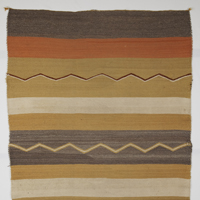
Wide Ruins style. Possibly from the Farmington, New Mexico area.Although most Wide Ruins rugs have complex design bands this piece is elegant in its simplicity. The earth tones and horizontal bands suggest the far horizon in the richly colored southwestern landscape, the zigzag lines the mountains.
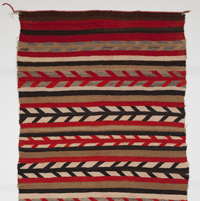
Chinle style.The asymmetrical barbed stripe design element seen in many of the rugs on exhibit was frequently found in the Chinle style textiles. Although Chinle style usually featured a subdued color palette, some rugs were bold and bright like this older piece.
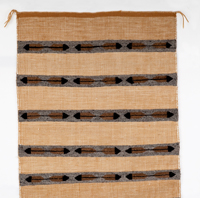
Crystal Revival. Instead of the typical wavy line motif, this Crystal style rug uses a different method to create columns of color. Instead of weaving two wefts of one color then two of another color as in the wavy line technique, the columns are formed by alternating colors each time the yarn is passed through the warp. Paired feather motifs float on narrow, mottled grey bands creating a simple banded design.
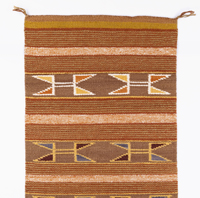
Crystal style. Both of these rugs contain the distinctive wavy line pattern of the Crystal style. The weaver creates the wavy line motif by alternating two wefts of one color with two of another. When tightly packed the alternating wefts create wavy lines. Typical motifs on Crystal style rugs include the squash blossom, stars, and diamonds.

Wide Ruins style. This rug exhibits none of the complex patterning seen in most the Wide Ruins style textiles. The use of ochre and shades of grey enhance the simple banded design. The addition of the arrow motifs adds just the right counterpoint to the horizontal bands and undulating mountains. The weaver ignored the complex patterning usually associated with the Wide Ruins style in favor of a simple approach.
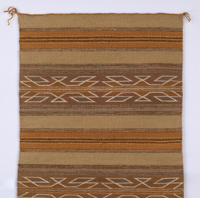
Wide Ruins Style
Pine Springs was one of the areas that specialized in Wide Ruins style rugs and this is a beautiful example featuring tightly spun yarns and fine weaving.
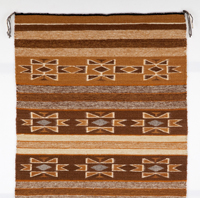
Crystal style. Both of these rugs contain the distinctive wavy line pattern of the Crystal style. The weaver creates the wavy line motif by alternating two wefts of one color with two of another. When tightly packed the alternating wefts create wavy lines. Typical motifs on Crystal style rugs include the squash blossom, stars, and diamonds.

Wide Ruins style. Sisters Mary and Sarah Nez created rugs in the Wide Ruins style using red, grey, black and white rather than the typical earth tones associated with the Wide Ruins design. Sarah Nez is from Klagetoh where grey backgrounds are traditional in Klagetoh style rugs. Ganado Red style rugs made in the same area feature red backgrounds. These sisters translated the Wide Ruins design using colors from other regional styles to produce unique pieces.